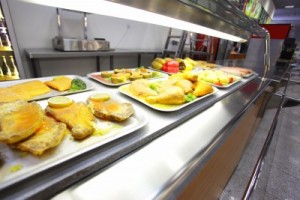
My mom was shocked at some of the schools—they really had a lot to choose from! From little markets, to pizzerias, to actual chain restaurants right smack in the union. She called me saying, “How do kids do it? They have so much food here, how does everyone keep the weight off?”. While weight is a tricky topic, some keep it off, some don’t, she was right in saying that the choices can be overwhelming. When should we indulge in treats, and when should we stick to the basics? Where are the good eats and where are they hiding the bad treats?
I look at dining halls in a couple of ways—take your school union for example. I’m sure that there are campus “fast-food” options, ready to pick up, and eat so you can run to class. At my school there is a sandwich stop, a pizza place, a stand that is also ready to serve chicken fingers and fries, and grill type option. In theory, all great food, but not so much if you are trying to watch the pounds.
Then there is the stable “Dining Hall”. Every day there is a different hot meal, your typical meat, vegetable, and carb. There are often different stations you can filter through—a salad bar, a soup stop, meat “carver”, a fruit bar—the options seem endless. You figure, “Hey, it’s all here, why not try it all”. In my opinion, that’s where we all go wrong.
The food on any campus is not going to be gourmet seven days a week, but it certainly isn’t down right bad for you. There are staples that help to create reliable balanced meals whatever your tastes are. You can stick to the planned meal; pick up whatever they are serving as a complete plate. However, most students take this as phase one. I’ve got the plate—what else can I add?
Students go from having a balanced meal—probably right in the zone for calories—a little protein, a potato of some sort (fries kind of count), and a vegetable. Then they add soup, grab some pasta, and maybe throw in a sandwich. Pretty soon it all starts to add up and before you know it, you have a full tray complete with soda, water, or a Powerade. Dining halls can be dangerous. Your eyes are almost always bigger than your stomach and anything can happen.
On the one hand you could eat everything on your plate—good for the kitchen, bad for your waistline. On the other hand, you could have all the food and really only touch a few things and shove peas around your plate. Students don’t realize how much food goes to waste when they pile up the plates on their tray only to discover they really aren’t that hungry later.
An important rule of thumb to consider when navigating your dining hall or school eating options is moderation. This isn’t the last time you are eating all week—it’s just one meal! Stick to the normal stuff, don’t pack it all on your tray! There will be more food in a few hours, tomorrow and the next day. It seems like you have to try it everything before some other student sneaks up behind you and takes it all, but I promise that won’t happen.
Try to align your eyes with you stomach and shoot for what you need as opposed to all the food you want—you could be making trips back and forth for hours if that’s the case. Food options can be tough, but remember that anything is good in moderation and small portions of anything can be great—as long as you don’t go overboard! Us your conscious as your food GPS and stick to the stuff that your mind and your body would say yes to. Maybe opt out of the ice cream bar and the choc chip cookie and settle for just one!
-Ring Queen
I’m reading Statistics for Behavioral Sciences